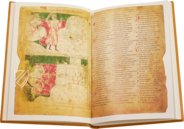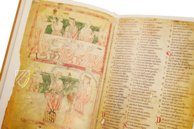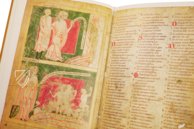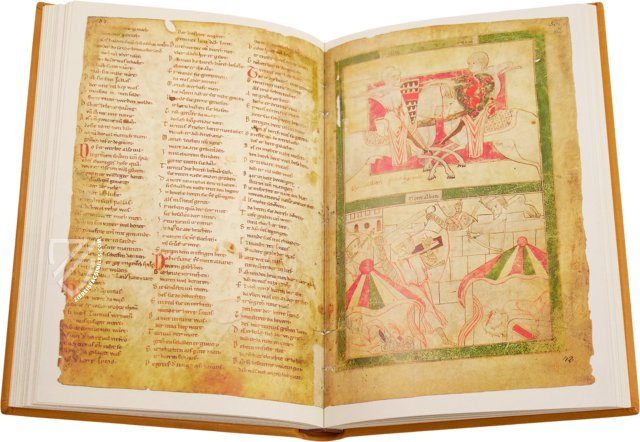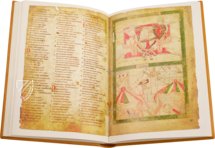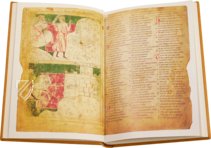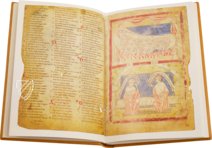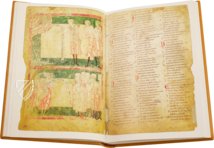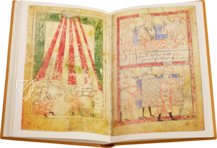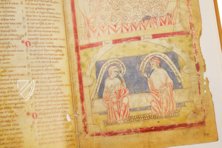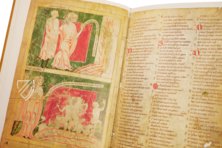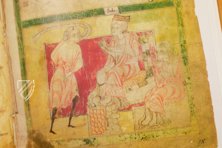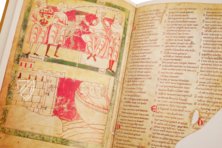Heinrich von Veldeke - Eneas Romance
(1,000€ - 3,000€)
Often referred to in English as the Eneit, the Eneas Romance is one of the cornerstones of the German language: it is the oldest courtly romance, one of the oldest secular works, and the first translation of an ancient novel into German that was not undertaken by a member of the clergy. It was written by Heinrich von Veldeke between 1170 and 1188 and although the author was a Flemish speaker, he chose a Franconian dialect similar to that used in Eilhart von Oberg’s Tristrant und Isalde. Rather than being based directly on the Latin text of Virgil’s Aeneid, it is modeled on the French Roman d’Eneas. This explains the odd spelling of the title as well why Virgil’s ancient epic was turned into a courtly romance minutely analyzing the psychology of love. Both Gottfried von Strassburg and Wolfram von Eschenbach attested to having been influenced by the example of Veldeke’s Eneasromance.
Heinrich von Veldeke - Eneas Romance
Courtly love, courtly virtues such as moderation, self-control, eloquence, etc., and the beauty of courtly life are presented in the greatest and most influential work by Heinrich von Veldeke (ca. 1150 – after 1188). It is inspired on the Roman d’Eneas, which was written ca. 1160 in Old French and is loosely based on the Aeneid by Virgil (70–90 BC) but focuses mostly on the romantic relationships of the hero “Eneas” (Aeneas) with Queen Dido and Princess Lavinia. As the first courtly romance written in German, it is one of the oldest and most important works written in this language and according to Gottfried von Strassburg (d. ca. 1210), Veldeke "made the first graft on the tree of German". The action in the text is often interrupted by detailed descriptions of garments, weapons and armor, tombs, and more to create a rich picture of court life at the end of the 12th century. The splendid Berlin manuscript is adorned with 136 half- and full- page miniatures in the Bavarian Romanesque style and was created ca. 1220–30.
Creation of the Work
It is believed that Heinrich von Veldecke began translating the Roman d’Eneas with the encouragement of the Countess Margaret of Cleves (d. 1190) and began writing his version ca. 1170. It was mostly complete when it was stolen in 1174 from one of her ladies in waiting during the wedding feast celebrating her marriage to Landgrave Ludwig III of Thuringia (1151/52–1190). The identity of the thief remains debated today. The manuscript was recovered in 1183/84 through the mediation of Ludwig’s brother, Count Palatine Hermann von Neuenburg, and Ludwig’s other brother, future Landgrave Hermann of Thuringia (d. 1217), who commissioned Heinrich with completing the work, which he did in 1188. It has been debated whether Heinrich initially wrote the work in the Maaslandic (Middle Dutch) language spoken in Cleves and then translated it into Middle High German, which was spoken in Thuringia. The rhymes selected by Heinrich were possible in both languages, indicating that he sought to reach as wide of an audience as possible while exerting minimal effort as a scribe.
The Romantic Adventures of Eneas
After relating the Fall of Troy and the flight of Eneas and his entourage, most of the beginning of the work revolves around Dido and events in Carthage. Dido is presented as the extraordinarily rich and powerful founder and ruler of Carthage who is respected for her intelligence as well as her beauty. However, she falls violently in love with Eneas and despite trying to conceal her feelings and resisting his advances for some time, she eventually gives herself to Eneas in the forest. This passion causes her to lose her prudence and when Eneas announces he is leaving for Italy, she berates him and expresses regret, burning all the gifts he gave her. Dido ends up killing herself with Eneas’ sword and everyone is shocked at what has happened to her. The plot of Lavinia, his second love interest, is considerably longer but less complicated because her feelings are reciprocated by Eneas. The comparison of the two plotlines juxtaposes the happiness and sorrow of courtly love and has dynastic implications as well: while the passionate affair with Dido causes to the downfall of Carthage, the loving, loyal marriage with Lavinia leads to the establishment of a Trojan kingdom in Italy.
Codicology
- Alternative Titles
- Heinrich von Veldeke: Aeneid
Aeneit
Eneit
Eneid
Aeneas-Roman
Roman d'Enéas
Heinrich von Veldeke - Eneas-Roman - Size / Format
- 148 pages / 25.5 × 17.3 cm
- Origin
- Germany
- Date
- Ca. 1220–1230
- Epochs
- Style
- Genre
- Language
- Content
- German adaption of Virgil's Aeneid modeled on the French Roman d’Eneas
- Artist / School
- Heinrich von Veldeke (author)
Heinrich von Veldeke - Eneas Romance
Wedding of Eneas and Dido
In Veldeke’s narrative, Dido is a female figure of extraordinary power and intelligence who rules over Carthage, which she founded. Induced by Venus and Cupid, she falls deeply in love with Eneas upon his arrival but tries her best to hide her feelings until he seduces her in the forest. Their wedding feast is depicted with diminutive servants bringing food to the feast on bended knee as guests approach on the left to present their gifts. However, they will soon be separated by the will of the gods.

Heinrich von Veldeke - Eneas Romance
Assault on Troy
Although the story is focused on chivalrous behavior, the miniatures of the manuscript are also a valuable source on contemporary life, or in this case, contemporary arms and armor. Despite the damage to this page, it contains an early depiction of the enclosed steel helmet that emerged in the late 12th century and eventually developed into the more famous “great helm” of the 13th and 14th centuries.
The miniature shows how the helmet, with holes for sight and breathing, was worn over a mail coif. A single archer is depicted wearing a simple open-faced helmet with a wide brim, a so-called “kettle hat”. After being depicted in Carolingian art, they seem to have fallen out of use before reappearing at the same time as the enclosed helmet.

#1 Eneas-Roman
Language: German
(1,000€ - 3,000€)
- Treatises / Secular Books
- Apocalypses / Beatus
- Astronomy / Astrology
- Bestiaries
- Bibles / Gospels
- Chronicles / History / Law
- Geography / Maps
- Saints' Lives
- Islam / Oriental
- Judaism / Hebrew
- Single Leaf Collections
- Leonardo da Vinci
- Literature / Poetry
- Liturgical Manuscripts
- Medicine / Botany / Alchemy
- Music
- Mythology / Prophecies
- Psalters
- Other Religious Books
- Games / Hunting
- Private Devotion Books
- Other Genres
- Afghanistan
- Armenia
- Austria
- Belgium
- Colombia
- Croatia
- Cyprus
- Czech Republic
- Denmark
- Egypt
- Ethiopia
- France
- Germany
- Greece
- Hungary
- India
- Iran
- Iraq
- Israel
- Italy
- Japan
- Lebanon
- Luxembourg
- Mexico
- Morocco
- Netherlands
- Palestine
- Peru
- Poland
- Portugal
- Russia
- Serbia
- Spain
- Sri Lanka
- Sweden
- Switzerland
- Syria
- Turkey
- Ukraine
- United Kingdom
- United States
- Uzbekistan
- Aboca Museum
- Ajuntament de Valencia
- Akademie Verlag
- Akademische Druck- u. Verlagsanstalt (ADEVA)
- Aldo Ausilio Editore - Bottega d’Erasmo
- Alecto Historical Editions
- Alkuin Verlag
- Almqvist & Wiksell
- Amilcare Pizzi
- Andreas & Andreas Verlagsbuchhandlung
- Archa 90
- Archiv Verlag
- Archivi Edizioni
- Arnold Verlag
- ARS
- Ars Magna
- ArtCodex
- AyN Ediciones
- Azimuth Editions
- Badenia Verlag
- Bärenreiter-Verlag
- Belser Verlag
- Belser Verlag / WK Wertkontor
- Benziger Verlag
- Bernardinum Wydawnictwo
- BiblioGemma
- Biblioteca Apostolica Vaticana (Vaticanstadt, Vaticanstadt)
- Bibliotheca Palatina Faksimile Verlag
- Bibliotheca Rara
- Boydell & Brewer
- Bramante Edizioni
- Bredius Genootschap
- Brepols Publishers
- British Library
- C. Weckesser
- Caixa Catalunya
- Canesi
- CAPSA, Ars Scriptoria
- Caratzas Brothers, Publishers
- Carus Verlag
- Casamassima Libri
- Chavane Verlag
- Christian Brandstätter Verlag
- Circulo Cientifico
- Club Bibliófilo Versol
- Club du Livre
- CM Editores
- Collegium Graphicum
- Collezione Apocrifa Da Vinci
- Comissão Nacional para as Comemorações dos Descobrimentos Portugueses
- Coron Verlag
- Corvina
- CTHS
- D. S. Brewer
- Damon
- De Agostini/UTET
- De Nederlandsche Boekhandel
- De Schutter
- Deuschle & Stemmle
- Deutscher Verlag für Kunstwissenschaft
- DIAMM
- Droz
- E. Schreiber Graphische Kunstanstalten
- Ediciones Boreal
- Ediciones Grial
- Ediclube
- Edições Inapa
- Edilan
- Editalia
- Edition Deuschle
- Edition Georg Popp
- Edition Leipzig
- Edition Libri Illustri
- Editiones Reales Sitios S. L.
- Éditions de l'Oiseau Lyre
- Editions Medicina Rara
- Editorial Casariego
- Editorial Mintzoa
- Editrice Antenore
- Editrice Velar
- Edizioni Edison
- Egeria, S.L.
- Eikon Editores
- Electa
- Emery Walker Limited
- Enciclopèdia Catalana
- Eos-Verlag
- Ephesus Publishing
- Ernst Battenberg
- Eugrammia Press
- Extraordinary Editions
- Fackelverlag
- Facsimila Art & Edition
- Facsimile Editions Ltd.
- Facsimilia Art & Edition Ebert KG
- Faksimile Verlag
- Feuermann Verlag
- Folger Shakespeare Library
- Franco Cosimo Panini Editore
- Friedrich Wittig Verlag
- Fundación Hullera Vasco-Leonesa
- G. Braziller
- Gabriele Mazzotta Editore
- Gebr. Mann Verlag
- Gesellschaft für graphische Industrie
- Getty Research Institute
- Giovanni Domenico de Rossi
- Giunti Editore
- Graffiti
- Grafica European Center of Fine Arts
- Guido Pressler
- Guillermo Blazquez
- Gustav Kiepenheuer
- H. N. Abrams
- Harrassowitz
- Helikon
- Hendrickson Publishers
- Henning Oppermann
- Herder Verlag
- Hes & De Graaf Publishers
- Hoepli
- Holbein-Verlag
- Hortus Deliciarum
- Houghton Library
- Hugo Schmidt Verlag
- Idion Verlag
- Il Bulino, edizioni d'arte
- ILte
- Imago
- Insel Verlag
- Instituto Nacional de Antropología e Historia
- Istituto dell'Enciclopedia Italiana - Treccani
- Istituto Ellenico di Studi Bizantini e Postbizantini
- Istituto Geografico De Agostini
- Istituto Poligrafico e Zecca dello Stato
- Italarte Art Establishments
- J. Thorbecke
- Jan Thorbecke Verlag
- Johnson Reprint Corporation
- Josef Stocker
- Josef Stocker-Schmid
- Jugoslavija
- Karl W. Hiersemann
- Kasper Straube
- Kaydeda Ediciones
- Kindler Verlag / Coron Verlag
- Kodansha International Ltd.
- Konrad Kölbl Verlag
- Kurt Wolff Verlag
- La Liberia dello Stato
- La Linea Editrice
- La Meta Editore
- Lambert Schneider
- Landeskreditbank Baden-Württemberg
- Leo S. Olschki
- Les Incunables
- Library of Congress
- Libreria Musicale Italiana
- Lichtdruck
- Lito Immagine Editore
- Lumen Artis
- Lund Humphries
- M. Moleiro Editor
- Maison des Sciences de l'homme et de la société de Poitiers
- Manuscriptum
- Martinus Nijhoff
- Maruzen-Yushodo Co. Ltd.
- MASA
- McGraw-Hill
- Militos
- Millennium Liber
- Müller & Schindler
- Nahar and Steimatzky
- National Library of Wales
- Neri Pozza
- Nova Charta
- Oceanum Verlag
- Odeon
- Orbis Mediaevalis
- Orbis Pictus
- Österreichische Staatsdruckerei
- Oxford University Press
- Pageant Books
- Parzellers Buchverlag
- Patrimonio Ediciones
- Pattloch Verlag
- PIAF
- Pieper Verlag
- Plon-Nourrit et cie
- Prestel Verlag
- Princeton University Press
- Prisma Verlag
- Priuli & Verlucca, editori
- Pro Sport Verlag
- Propyläen Verlag
- Pytheas Books
- Quaternio Verlag Luzern
- Reales Sitios
- Recht-Verlag
- Reichert Verlag
- Reichsdruckerei
- Riehn & Reusch
- Roberto Vattori Editore
- Rosenkilde and Bagger
- Roxburghe Club
- Salerno Editrice
- Sarajevo Svjetlost
- Schöck ArtPrint Kft.
- Scolar Press
- Scrinium
- Scripta Maneant
- Scriptorium
- Siloé, arte y bibliofilia
- SISMEL - Edizioni del Galluzzo
- Sociedad Mexicana de Antropología
- Société des Bibliophiles & Iconophiles de Belgique
- Soncin Publishing
- Sorli Ediciones
- Stainer and Bell
- Studer
- Styria Verlag
- Sumptibus Pragopress
- Szegedi Tudomànyegyetem
- Taberna Libraria
- Tarshish Books
- Taschen
- Tempus Libri
- Testimonio Compañía Editorial
- Thames and Hudson
- The Clear Vue Publishing Partnership Limited
- The Facsimile Codex
- The Folio Society
- The Marquess of Normanby
- The Richard III and Yorkist History Trust
- Tip.Le.Co
- TouchArt
- TREC Publishing House
- TRI Publishing Co.
- Trident Editore
- Typis Regiae Officinae Polygraphicae
- Union Verlag Berlin
- Universidad de Granada
- University of California Press
- University of Chicago Press
- Urs Graf
- Vallecchi
- Van Wijnen
- VCH, Acta Humaniora
- VDI Verlag
- VEB Deutscher Verlag für Musik
- Verlag Anton Pustet / Andreas Verlag
- Verlag Bibliophile Drucke Josef Stocker
- Verlag der Münchner Drucke
- Verlag für Regionalgeschichte
- Verlag Styria
- Vicent Garcia Editores
- W. Turnowsky
- Waanders Printers
- Wiener Mechitharisten-Congregation (Wien, Österreich)
- Wissenschaftliche Buchgesellschaft
- Wydawnictwo Dolnoslaskie
- Xuntanza Editorial
- Zakład Narodowy
- Zollikofer AG








